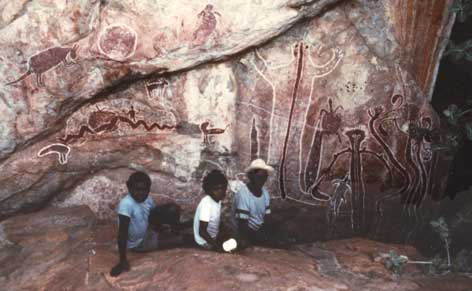Superimposition
 Aborigines at Australian pictogram site
|
There is considerable scope in the use of superimposition of motifs which has hardly been explored so far. Some researchers have admitted that they find it difficult to decide which of two overlapping motifs precedes the other, especially for petroglyphs. This illustrates very well the inadequacies of rock art research as it has been widely practised. Microscopic study of superimpositions offers many means of distinguishing between peck marks of different ages, or between paint residues applied over or under others. Examination of the edges of areas of paint residue should certainly permit a clear definition of superimposition sequence. The only exceptions would be cases where significant mixing of paints has occurred, because the application of the superimposing paint layer has mobilised the earlier paint; or in cases of severe degradation of paintings or drawings. However, nanostratigraphic studies of paint layers have been used very profitably in Australia, by A. Watchman, J. Clarke and others, and have shown well-defined stratigraphies of up to about forty-four layers of paint (Clarke 1976; cf. also Watchman 2000; Watchman and Campbell 1996).
Superimpositions of petroglyphs may seem more difficult to determine, especially if the time span between the two events is very short and differential weathering cannot be detected. However, even these cases yield their sequence if individual impact scars along the edge of the superimposition are examined under magnification. There are always diagnostic features, such as truncated scars. With abrasion petroglyphs, methods similar to those developed for portable art objects, called ‘internal analysis’ by Marshack (1972, 1975, 1985, 1989, 1992), are usually most helpful. They involve the examination of features such as crossing grooves under a binocular microscope, and they fail only in the case of heavily weathered engravings.
Superimposition as such provides of course only relative age information, as it does permit us to distinguish the older from the more recent motif. Naturally they may be separated by only a very brief time, even minutes, so traditional forms of studying superimpositions are of very limited use. However, if these studies were conducted in a more systematic and rigorous way, involving field microscopy, they are highly likely to yield considerably more reliable information. In particular, microscopic studies of this kind can include comparative studies of relative erosion (Bednarik 1995a). Indeed, when used together with methods of direct dating, the analysis of superimpositions can be a very potent tool of rock art science. While superimposition as such has been exploited by hundreds of researchers throughout the 20th century, more formal analysis has become available through the introduction of Harris matrices during the last decade (Chippindale and Tacon 1993; Loubser 1993, 1996).
| Rock art dating – back to main page
References list for rock art dating |